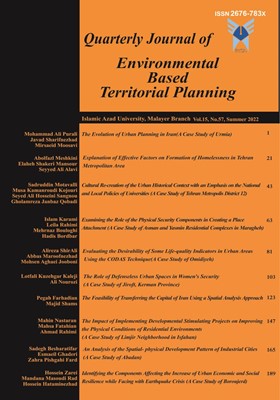An Analysis of the Spatial- physical Development Pattern of Industrial Cities (A Case Study of Abadan)
Subject Areas :
sadegh besharatifar
1
![]() ,
ghaderi Esmaeil
2
,
Zahra Pishgahi Fard
3
,
ghaderi Esmaeil
2
,
Zahra Pishgahi Fard
3
1 - Ph.D. candidate, Department of Geography & Urban Planning, Science and Research Branch, Islamic Azad University, Tehran, Iran
2 - Assistant professor, Department of Geography & Rural Planning, Allameh Tabatabai University, Tehran, Iran
3 - full professor, Department of Political Geography, Science and Research Branch, Islamic Azad University, Tehran, Iran
Keywords: physical development, Oil Industry, Abadan, oil cities,
Abstract :
The results of the present study showed that according to the selective separation analysis index in 1360, the physical-spatial structure of Abadan was of the type of concentration with relative selective separation. The results of the t-test indicate that there is a significant difference between the areas related to the oil industry and other urban areas of Abadan in terms of the texture index. As the results derived from Moran's model showed, by creating more services, the oil industry was able to provide the basis for many dense constructions in its dependent localities compared to other localities and the basis for creating a kind of intense physical concentration and a concentrated and cluster growth pattern. But in 1390, many neighborhoods with a percentage of dense tissue appeared in the structure of the city, causing very dense neighborhoods to be scattered in terms of urban texture in Abadan, and the pattern of physical growth changed from concentrated and clustered in 1360 to a pattern of less concentration (scattered) and randomly change 1390. Also, the results of Pearson's correlation coefficient test show that there is no strong and significant relationship between the immigrants who entered the city and the number of oil industry workers, and the number of construction permits issued. Therefore, from 1360 to 1390, a factor such as the reconstruction of the city after the war, together with other physical-spatial changes, influenced the city's mode and expansion and pushed the city's growth pattern from a cluster to a scattered one.
_||_


